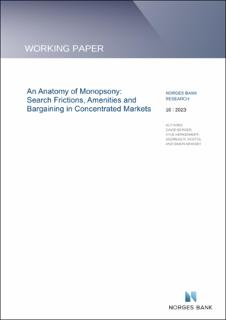| dc.contributor.author | Berger, David | |
| dc.contributor.author | Herkenhoff, Kyle | |
| dc.contributor.author | Kostol, Andreas R. | |
| dc.contributor.author | Mongey, Simon | |
| dc.date.accessioned | 2023-06-27T08:47:31Z | |
| dc.date.available | 2023-06-27T08:47:31Z | |
| dc.date.issued | 2023 | |
| dc.identifier.isbn | 978-82-8379-287-4 | |
| dc.identifier.issn | 1502-8143 | |
| dc.identifier.uri | https://hdl.handle.net/11250/3073382 | |
| dc.description.abstract | We contribute a theory in which three channels interact to determine the degree of monopsony power and therefore the markdown of a worker’s spot wage relative to her marginal product: (1) heterogeneity in worker-firm-specific preferences (non-wage amenities), (2) firm granularity, and (3) off- and on-the-job search frictions. We use Norwegian data to discipline each channel and then reproduce new reduced-form empirical relationships between market concentration, job flows, wages and wage inequality. In doing so we provide a novel method for clustering occupations into local labor markets. Our main exercise quantifies the contribution of each channel to income inequality and wage markdowns. The average markdown is 21 percent in our baseline estimation. Removing nonwage amenity dispersion narrows them by a third. Giving the next-lowest-ranked competitor a seat at the bargaining table narrows them by half, suggesting that granularity and strategic interactions in the bargaining process is an important source of markdowns. Removing search frictions narrows them by two-thirds. Each counterfactual reduces wage inequality and increases welfare. | en_US |
| dc.language.iso | eng | en_US |
| dc.publisher | Norges Bank | en_US |
| dc.relation.ispartofseries | Working paper;10/2023 | |
| dc.rights | Attribution-NonCommercial-NoDerivatives 4.0 Internasjonal | * |
| dc.rights.uri | http://creativecommons.org/licenses/by-nc-nd/4.0/deed.no | * |
| dc.subject | monopsony | en_US |
| dc.subject | inequality | en_US |
| dc.subject | JEL: E2 | en_US |
| dc.subject | JEL: J2 | en_US |
| dc.subject | JEL: J42 | en_US |
| dc.title | An anatomy of monopsony : Search frictions, amenities and bargaining in concentrated markets | en_US |
| dc.type | Working paper | en_US |
| dc.description.version | publishedVersion | en_US |
| dc.subject.nsi | VDP::Samfunnsvitenskap: 200::Økonomi: 210::Samfunnsøkonomi: 212 | en_US |
| dc.source.pagenumber | 54 | en_US |

